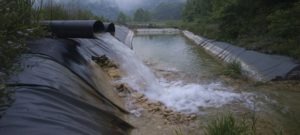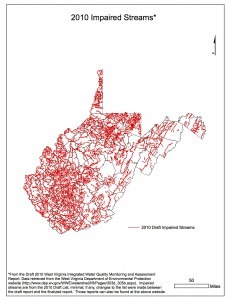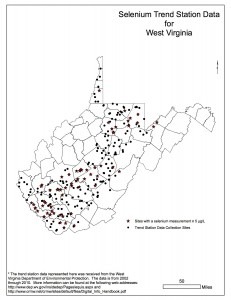
More than 40 percent of West Virginia’s rivers are too polluted to pass simple water-quality safety thresholds. They are too polluted to be safely used for drinking water or recreation, or to support healthy aquatic life.
This is due in large part to pollution from decades of mining. From ongoing pollution from active mountaintop removal mines and toxic discharges from poorly reclaimed mines, the quality streams of West Virginia has never been more degraded.
According to the 2012 Draft West Virginia Integrated Water Quality Monitoring and Assessment Report by the West Virginia Department of Environmental Protection, less than a quarter of West Virginia streams fully support all or some of their assessed uses.
The state has failed to collect sufficient data to determine the health of 36 percent of the streams in the state.
In many ways, Appalachian Mountain Advocates has had to take over the job of weak West Virginia state agencies like DEP that have failed to protect the environment. In addition to our legal challenges, we’ve been compiling and mapping West Virginia water quality data over the last several years. The results are a very graphic illustration of just what mining has done to West Virginia’s streams.
Streams can be impaired for a variety of reasons. Raw sewage, agricultural run-off or discharges from industrial plants all contribute to the degradation of stream health. But one of the largest contributors to the poor quality of West Virginia streams is the mining industry.
A brief glance at the map below (download the PDF here) of streams listed as impaired by the West Virginia Department of Environmental Protection shows no corner of the state is untouched.

Unfortunately, as dramatic as this graphic looks, it understates the true extent of the problem. More than a third of West Virginia streams haven’t been assessed, and hundreds of streams that should be on this list aren’t included because the state is trying to protect the coal industry and save coal companies hundreds of millions of dollars in cleanup costs.
Keep in mind that when the coal industry successfully evades such costs, the expense often falls on the taxpayers of the state.
Streams should be listed as impaired by DEP if they fail to meet state water quality standards for pollution.
However, following passage of SB 562 last year, DEP has stopped listing new biologically impaired streams — streams that can no longer support healthy aquatic life. This new practice is both an incorrect interpretation of SB 562 and a blatant violation of the Clean Water Act.
SB 562 was nothing more than a legislative attempt to protect the coal industry from millions of dollars worth of pollution cleanup costs. It required DEP to develop new thresholds for biological impairment. Rather than use existing thresholds until those new standards are developed, DEP officials simply quit using any threshold at all. This means long delays in cleanup of biologically impaired streams and big savings for DEP’s friends in the coal industry.
If DEP’s contention is that SB 562 constitutes a change to West Virginia’s current water quality standards, it is required to receive the approval of the U.S. Environmental Protection Agency prior to implementing that change. To date, EPA has not approved the drastic change being employed by DEP. The agency’s refusal to list biologically impaired streams as impaired is unfounded and illegal. DEP is denying these impaired streams the protection needed to improve the quality of the waters of West Virginia.
In any case, it’s clear that West Virginia’s waters are in trouble and that much of the problem is related to coal mining — both current production and a toxic legacy from past mining. That fact becomes glaringly obvious if you look at water concentrations of specific pollutants directly associated with mining.
If you want to see the link between mountaintop removal mining and selenium pollution, for instance, zoom in on the Google Earth Map here. The red lines indicate streams that the DEP listed in 2010 as violating water quality standards for selenium. The yellow lines indicate streams that Appalachian Mountain Advocates has identified as impaired for selenium based on data we’ve collected. After we submitted this data to DEP, many of the streams that we suggested were added to a DEP draft list of impaired streams.
The cluster of selenium-impaired streams in the southern coal fields of the state is not coincidence. If you zoom in close enough, you’ll see that all the streams have something in common: They are all near visible disturbance from surface mining.
Selenium pollution occurs when coal seams with high selenium levels are mined, exposing the once-buried selenium to surface run-off. Once the selenium is exposed, U.S. Forest Service biologist A. Dennis Lemly, author of an important 2008 report selenium, believes expensive pollution treatment will be required in perpetuity. The only way to prevent this is to avoid mining those coal seams.
If you’re interested in exploring water quality in West Virginia in more detail, check out the Trend Station information tab of DEP’s GIS Mining Data Tools page. Click on the link, then select the Trend Station icon (the brown water droplet.) The popup allows you to select a pollutant to view and you can set a threshold for detection levels.

We put together this map of the trend station data for selenium (click here to download the PDF). If you click on the image to bring up the full-size version, you’ll see that the bulk of the selenium issues are in the northern and southern coal fields.
A lot of our work at Appalachian Mountain Advocates is designed to protect West Virginia’s water quality, either by preventing future harm or ensuring those who caused the harm pay to clean it up.
As these maps demonstrate, it’s a big job, and too much damage has already been done.
Original Article: Appalachian Mountain Advocates
MORE:
Poll shows broad support for Clean Water Act
A poll of likely voters in West Virginia, Kentucky, Virginia and Tennessee released Tuesday, Aug. 16, 2011, shows widespread opposition to mountaintop removal mining and overwhelming support for the full enforcement and strengthening of the Clean Water Act to better protect streams, rivers and lakes from the impact of mountaintop removal mining.
The poll was conducted by Lake Research Partners and Bellwether Research & Consulting and commissioned by Appalachian Mountain Advocates, Earthjustice and the Sierra Club.
